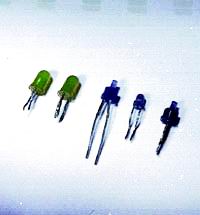10.3.1.4 - THE LIGHT EMITTING DIODE -
LED
In 1955, R. Braunstein had observed the generation of infrared radiation produced by charges applied over materials like Galliun Arsenide and Indium Phosphide. Through his researches he surmised the phenomenon was due to the direct recombination of electron-hole pairs and vacancies.
The photodiode is a device that converts electrical power into light. Basically it is much like an ordinary diode, except that it has a windows or lens that lets light falls onto the PN junction creating free electrons and vacancies. Its invention led to optoelectronics, a new field in microelectronics, whose reseraches discovered in 1958 that the principle of MASERS - microwave amplification by stimulated emission of radiation - could be applied to visible light, arising the idea of producing coeherent light - LASER - with semiconductor junctions. In this way, microwave field also became aware that semiconductors could be used either for generation as well as signal dectection, giving birth to a new type of diode. |

